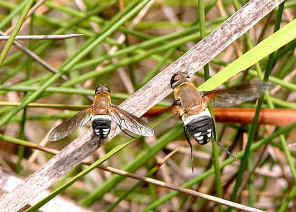Common Ligyra Bee Fly - Ligyra satyrus
Family Bombyliidae
This page contains pictures and information about Common Ligyra Bee Flies that we found in
the Brisbane area, Queensland, Australia.

- Body length 25mm
- This is a large Beefly with orange-brown thorax. Its abdomen is shiny-black with a white ring between thorax and abdomen. There are six white spots at the end of its egg-shaped abdomen. The wings are narrow and long with evenly darken colour and orange-brown near wing base..
-



- We noticed that this fly likes to rest on the ground, either on soil or on plant materials.



- This Bee Fly is common in open Eucalyptus forests in Brisbane, including Alexandra Hill and Karawatha Forest. They are usually found resting on the sandy ground. When disturbed, they slowly fly to another spot and rest few meters away.



- Their larvae are parasite to other insects of different species. Reference records show that they are hyperparasite of the scolid wasp, parasitic on the larva of asilid and hyperparasitoid of canegrubs (Scarab).











Bee Flies' Courtship



- We sometimes see two Bee Flies flying together, one larger and one smaller. The larger Bee fly chases the smaller one. When the smaller Bee Fly rests, the larger rests a few cm away. When the smaller Bee Fly flies, the larger follows closely.



- In the insects world, usually the females are larger in size. When courtship, usually the males chases the females. In this case, since the larger follows the smaller, we cannot tell which is the male and which is the female.


- The larger one The smaller one
- Reference:
- 1. Ligyra tantalus - by Takuro Tsukiji, 2006.
- 2. A review of the Australian species of the genus Ligyra Newman (Hyperlonia Olim) (Bombyliidae : Diptera) - SJ Paramonov, 1967.
- 3. Life history of Ligyra satyrus (Diptera: Bombyliidae) - Yeates DK, Logan D, Lambkin CL. Australian Journal of Entomology. 1999. 38: 300-304.
- 4. Northern Territory Insects, A Comprehensive Guide CD - Graham Brown, 2009.
